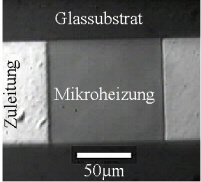Tintenstrahldrucker-Heizelement
(100µm x 100µm) bedeckt mit Wasserfilm
Thin-film
microheater (100µm x 100µm) from a thermal ink-jet
printhead covered with waterlayer
 |
 1
1 |
 2 2 |
 3 3 |
 4
4 |
 5
5 |
 6
6 |
 7
7 |
 8
8 |
 9
9 |
 10
10 |
 11
11 |
A voltage signal (25V, 5µs) is applied to the microscopic
heater pad (60 Ohm), causing the li-quid in contact with the
microheater to boil explosively. As the bubble density increases,
the microbubbles coalesce and form a coherent layer of vapor
film (a "big" bubble) covering the heater surface.
In thermal ink-jet printing the growing bubbles act like pistons
that propel ink through an orifice. After the end of the heating
pulse the bubble shrinks and breaks up into se-veral small bubbles.
The 11 images shown here cover a time period of 12µs. Taken by: |
Die Heizung (60 Ohm) wird mit einem kurzen 5µs Spannungspuls von 25 Volt erhitzt und erreicht eine Temperatur von über 400°C. Dadurch beginnt die Flüßigkeit auf dem Heizelement explosionsartig zu verdampfen. Kleine Blasen fügen sich zu einer großen Dampfblase zusammen, welche kontinuierlich wächst. Im Tintenstrahldrucker wird bei diesem Wachstumsprozeß ein Tintentropfen durch eine kleine Düse oberhalb des Heizelements ausgestoßen. Aufnahme: Nanolite Driver und Nanolite Lampe (FX) mit 100ns Blitzdauer. Zeit von Bild 1 bis 11 ca. 12µs. Autoren: |
||